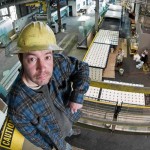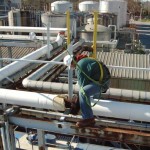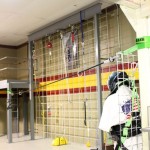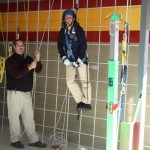May 2, 2014, 2:18 pm | by Ray Nardo
 According to the Bureau of Labor Statistics, in 2012, there were 544 fall-related fatalities. Of those cases, about one in four occurred from a fall of 10 feet or fewer. This statistic suggests something rather stark: It doesn’t take a whole lot of distance for a workplace accident to be fatal. As the person responsible for safety at your factory, you’re likely aware of the gruesome statistics. But, are you fully informed of all the various ways that fall protection systems keep your personnel safe? Read more.
According to the Bureau of Labor Statistics, in 2012, there were 544 fall-related fatalities. Of those cases, about one in four occurred from a fall of 10 feet or fewer. This statistic suggests something rather stark: It doesn’t take a whole lot of distance for a workplace accident to be fatal. As the person responsible for safety at your factory, you’re likely aware of the gruesome statistics. But, are you fully informed of all the various ways that fall protection systems keep your personnel safe? Read more.
March 28, 2014, 2:49 pm | by Ray Nardo
 Conducting annual lifeline inspections goes hand in hand with proper training of your workers. Your equipment isn’t protecting anyone when it has missing, worn or defective components. Worse, it can create an unwarranted illusion of security. Installing fall protection equipment in your workplace is a great first step towards keeping your employees working at heights safe from fall hazards. Read more.
Conducting annual lifeline inspections goes hand in hand with proper training of your workers. Your equipment isn’t protecting anyone when it has missing, worn or defective components. Worse, it can create an unwarranted illusion of security. Installing fall protection equipment in your workplace is a great first step towards keeping your employees working at heights safe from fall hazards. Read more.
March 21, 2014, 3:50 pm | by Ray Nardo
 A rescue plan is critical to any well-managed fall protection program, but it is an often-overlooked factor. Having a plan in place is necessary for any organization with workers at height. No one wants to see a co-worker hurt. Every employee working at a height must be prepared to act quickly in the event of an accident, specifically, because suspension trauma starts to set in within minutes. Read more.
A rescue plan is critical to any well-managed fall protection program, but it is an often-overlooked factor. Having a plan in place is necessary for any organization with workers at height. No one wants to see a co-worker hurt. Every employee working at a height must be prepared to act quickly in the event of an accident, specifically, because suspension trauma starts to set in within minutes. Read more.
March 14, 2014, 3:59 pm | by Ray Nardo
 While a comprehensive or strategic fall prevention or protection plan is certainly admirable, advantageous and the right long-term solution, it’s not always practical to implement all at once. The implementation of a complete solution is often a costly and time-consuming undertaking.
While a comprehensive or strategic fall prevention or protection plan is certainly admirable, advantageous and the right long-term solution, it’s not always practical to implement all at once. The implementation of a complete solution is often a costly and time-consuming undertaking.
Do you have to implement a comprehensive solution all at once, or piecemeal the installation? Read more.
March 7, 2014, 3:47 pm | by Ray Nardo
 As a facility manager in charge of worker safety, you know that when you have employees working from elevated areas, fall protection is essential. The potential for an accident to result in a serious injury or even death is very real.
As a facility manager in charge of worker safety, you know that when you have employees working from elevated areas, fall protection is essential. The potential for an accident to result in a serious injury or even death is very real.
Comprehensive fall protection for your workers requires more than simply installing safety equipment at elevated work areas. Without the proper training to instill best practices, your employees remain at risk.
The following six tips illustrate why your fall protection system is only as good as the instruction your workers receive.
Read more.
February 27, 2014, 9:00 am | by Ray Nardo
 Fall prevention encompasses every kind of equipment and application that is specifically set up to keep a person from falling in the first place. The purpose of prevention equipment is to eliminate or control the possibility of a person moving into a dangerous area. Fall arrest protection, on the other hand, is the backup system for someone who must enter a dangerous area and could lose their balance while working at height. The purpose of protection equipment is to eliminate or minimize injury potential.
Fall prevention encompasses every kind of equipment and application that is specifically set up to keep a person from falling in the first place. The purpose of prevention equipment is to eliminate or control the possibility of a person moving into a dangerous area. Fall arrest protection, on the other hand, is the backup system for someone who must enter a dangerous area and could lose their balance while working at height. The purpose of protection equipment is to eliminate or minimize injury potential.
Coach Vince Lombardi said, “It’s not whether you fall down. It’s whether you get back up.” We agree with Coach Lombardi that, in life, getting back up is important. However, in the case of elevated work situations, whether you fall in the first place is equally, if not more, important. There are different mitigation techniques, depending on the hazard.
Read more.
February 9, 2014, 7:40 pm | by Ray Nardo
 Did you know that nearly 400 people in the construction industry alone die each year due to injuries caused by falls? Not only that, but these accidents also cause many other serious injuries including incapacitation, broken bones and fractures, and long-term medical complications such as brain and spinal cord trauma.
Did you know that nearly 400 people in the construction industry alone die each year due to injuries caused by falls? Not only that, but these accidents also cause many other serious injuries including incapacitation, broken bones and fractures, and long-term medical complications such as brain and spinal cord trauma.
As the manager of your facility, it’s your job (and OSHA-enforced responsibility) to protect employees’ well being while working from heights. While worker safety should always be the number one priority, the financial impact to the business also has great potential for damage.
Read more.
 According to the Bureau of Labor Statistics, in 2012, there were 544 fall-related fatalities. Of those cases, about one in four occurred from a fall of 10 feet or fewer. This statistic suggests something rather stark: It doesn’t take a whole lot of distance for a workplace accident to be fatal. As the person responsible for safety at your factory, you’re likely aware of the gruesome statistics. But, are you fully informed of all the various ways that fall protection systems keep your personnel safe? Read more.
According to the Bureau of Labor Statistics, in 2012, there were 544 fall-related fatalities. Of those cases, about one in four occurred from a fall of 10 feet or fewer. This statistic suggests something rather stark: It doesn’t take a whole lot of distance for a workplace accident to be fatal. As the person responsible for safety at your factory, you’re likely aware of the gruesome statistics. But, are you fully informed of all the various ways that fall protection systems keep your personnel safe? Read more.






